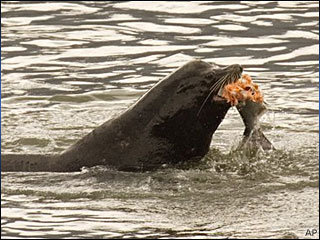forum
library
tutorial
contact

An Upstream Battle Over Chinook Salmon
by Editorial BoardLos Angeles Times, March 12, 2010
|
the film forum library tutorial contact |

|
An Upstream Battle Over Chinook Salmonby Editorial BoardLos Angeles Times, March 12, 2010 |
 Even among those who seek to protect wildlife above all, there are moments of great conflict. One of those moments is playing out near Portland, Ore., as sea lions gorge on endangered chinook salmon that gather at the base of the Bonneville Dam, preparing to make their way up the fish ladders to spawn. Last week and this, wildlife officials have killed six of the most incorrigible of the animals, which have refused to be dissuaded by noise, rubber bullets or other harassing techniques.
Even among those who seek to protect wildlife above all, there are moments of great conflict. One of those moments is playing out near Portland, Ore., as sea lions gorge on endangered chinook salmon that gather at the base of the Bonneville Dam, preparing to make their way up the fish ladders to spawn. Last week and this, wildlife officials have killed six of the most incorrigible of the animals, which have refused to be dissuaded by noise, rubber bullets or other harassing techniques.
As regrettable as the dilemma is, the government made the right choice. The population of California sea lions, the kind mainly responsible for the salmon-fest, has been burgeoning, while chinook salmon have presented policymakers with a persistent conservation problem. Their numbers along the Columbia River and elsewhere have been falling, and several runs of the fish are listed as threatened under the federal Endangered Species Act.
This season's salmon run is especially important because favorable ocean conditions led to an unusually robust population. More than twice as many fish as last year -- close to 500,000 -- are expected to swim up the Columbia River. That would be the biggest spring run in 70 years.
The larger population should not be seen as a sign that the fish's problems are abating. Loss of habitat, global warming and migration barriers posed by dams farther upstream, along the lower Snake River, have been contributing to an overall decimation of the chinook salmon population for decades. Rather, this is an opportunity to protect as many of the salmon as possible -- partly by reducing predation by sea lions that swim upriver for an easy meal.
This decision by state and federal wildlife authorities was an easy one. But what if, instead, the marine mammals causing the problem had been Steller sea lions, which are themselves endangered? Chinook salmon also make up 80% of the diet of killer whales; should we kill the killer whales too?
The federal government has spent $8 billion trying to restore salmon populations without fish ladders and hatcheries. It hasn't worked. Meanwhile, the Obama administration has been trying to get federal courts to approve a plan, barely improved on since the court-rejected plan of the George W. Bush years, that would keep the fish on the edge of endangerment instead of bringing back a flourishing fishery.
A better solution for all of these creatures would be a strong plan from the Obama administration on recovery for the Columbia River salmon, including the possibility of breaching one or more dams along the lower Snake River.
learn more on topics covered in the film
see the video
read the script
learn the songs
discussion forum
